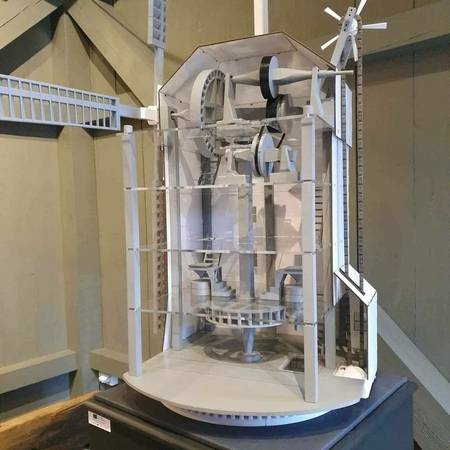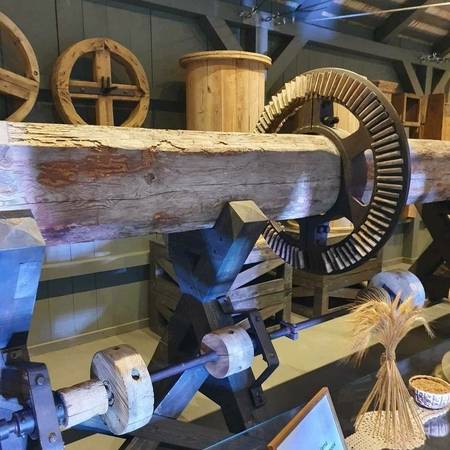The new exhibition about the unique windmill that stood in Kantvainiai.
The windmill of Jonas Genys, which more than a hundred years ago used to greet passersby with its wide wing swings, became, as time passed, a legend that also attracts curious visitors today. The new exhibition, near the ethnographic homestead in Agluonėnai, shares details about the uniqueness of this wind giant and the history of ‘exile’, about the fates of its owners, millers and residents.
Technical data and history of the mill
The windmill of Jonas Genys is known for its original engineering solutions. Unlike most windmills, this 13-metre-high structure along the wind direction was used to rotate with its entire body because it was equipped with a castor system with a ring rail. A turbine called a ‘wind rose’ was used to catch the wind, and the wings, unlike in other mills, were covered with blinds made of planks. It is known that the mill, which was renovated in 1912, milled grain until the 7th decade of the 20th century. Later, it was dismantled and removed with the hope of restoring it and making it accessible to visitors in the Open-Air Museum of Lithuania in Rumšiškės. This idea was never implemented.
The dramatic story of this unique technical giant united the local community in the quest to recover the parts of the windmill, which are now exhibited in the new exposition near the ethnographic homestead in Agluonėnai.
The importance of mills to the local community
The profession of a miller was one of the most respected in the rural community. Millers used to provide the residents of the surrounding areas with feed for livestock, flour and groats for food and sawn wood for household needs. The number of mills and millers in the territory was determined by the size of the community residing around and by its needs. In the 19th and 20th centuries, the Klaipeda region was easier to manage, with many windmills in the landscape.
Miller Jonas Genys
The collected memoirs of residents tell us that Jonas Genys, the owner of the Kantvainiai mill, was a professional miller with the right to give apprentices the miller title. He was also a good blacksmith and an educated man who subscribed to the
Deutscher Mühler magazines.
The writer Ieva Simonaitytė tells us about Jonas Genys in her memoirs:
Jonas Genys was a well-read, intelligent person and a certain kind of philosopher. He didn't talk much, but his words were very accurate. And I waited patiently, or maybe even impatiently, to hear his philosophical views. He was rarely at home. The mill used to hum and creak around the clock.
Local history
The windmill of Jonas Genys stood in Kantvainiai village near Agluonėnai (in the current Klaipeda district). Kantvainiai, Kantvonai (German: Kantweinen) is a village with its name derived from a personal name. It is believed that Richard Kant, the great-grandfather of philosopher Immanuel Kant, a professor at Königsberg University, lived here. He shortened his surname from Kantvainis to Kantas.
Kantvainiai village is situated near Agluonėnai, first mentioned in written sources in 1540. Nowadays, Agluonėnai is the centre of the eldership. The architecture and traditions of the town remind us that it was a former part of the Klaipeda region (ethnographic region of Lithuania Minor).
We invite you to visit the ethnographic homestead in Agluonėnai, in which the homestead of Prussian Lithuanians of the end of the 19th century, furniture and household items have been preserved, and the way of life and worldview of their owners are presented in the education, events, and exhibitions of the museum. Performances of the Barn Theatre of Agluonėnai and traditional Užgavėnės and Saint John‘s Eve events have been held in this homestead for more than 40 years. The apple orchard, nurtured by the locals, is growing in the central part of the town, and nearby, by the Agluona River, there is the oak grove of Prussian Lithuanians.
When travelling around the coastal region of Lithuania or the Curonian Lagoon region, visit Agluonėnai, where local excursions and educational activities are organised.
Call +370 665 24 278 or write an e-mail to agluonenu@gargzdumuziejus.lt (Klojimo Str. 9, Agluonėnai, Klaipeda district) to inquire about the 'The Story of the Wind Giant' exhibitions and others in the ethnographic homestead in Agluonėnai.
Educational offers:
• I heard the news at the mill
• The Mill Theatre
• Way of life of ancient Prussian Lithuanians
• Wool journey and felting
• Searching for treasure
The list of all the educational courses offered can be accessed on the website www.gargzdumuziejus.lt.










Reviews